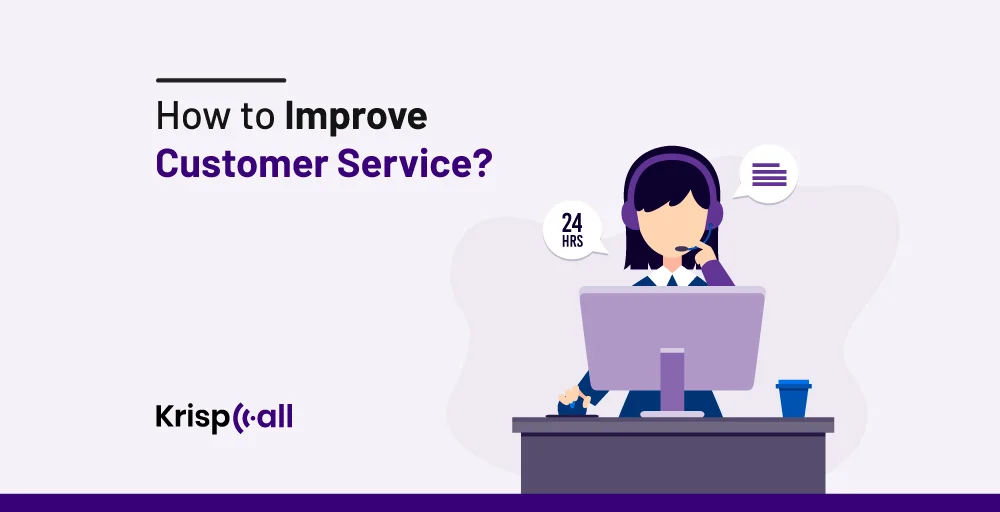Exceptional customer service is no longer a nicety – it is a necessity 😟for every business to persist in this competitive market.
Research also shows that people are likelier to tell others about poor customer service than good customer service. That’s why going above and beyond in customer service is crucial—it’s not just about delivering top-notch products anymore. Creating unforgettable experiences for your customers builds trust and cultivates loyalty like nothing else can!
In this guide, we will discuss the importance of customer service and its key elements. Lastly, we give you some advice on how to improve customer service for your business.
🔑 KEY HIGHLIGHTS
- Customer service means providing support to customers before, during, or after the sale.
- A great customer service helps to build trust, encourage repeat business, and build a positive brand image among customers.
- Prioritizing the demands of your customers and clarifying the customer’s goals and roadblocks are some key elements of good customer service.
- To improve customer service, comprehend the customer’s needs, and promote customer feedback to identify areas for improvement.
What is customer service?
Customer service is the process of providing assistance or support to new or existing customers. It can be before, during, or after the sale. Customer service includes a range of activities that involve resolving complaints, providing guidance, answering questions, and finding solutions.
For instance, imagine you sell a product, and the customer needs guidance to set it up. This is where customers may ask you for assistance. During this situation, your customer service team must thoroughly explain how to set up.
In simple terms, customer service refers to offering a service to meet the needs of your customers and assisting them in solving their issues.
Why is great customer service important?
There is no denying that high-quality products are important, but a great service is equally important for your business.
If you are not able to provide a good experience, customer has no qualms about spending their money elsewhere. Research also suggests that 81% of people claim that obtaining good customer service drives them more likely to make another purchase. Thus, great customer service is always important.
Remember that happy customers become brand advocates, advising your products or services and generating positive word-of-mouth. Also, when you provide excellent customer service, it builds trust, encourages repeat business, and builds a positive brand image and reputation among customers.
In addition, in this digital era, the customer leaves a review about your business online, which reaches thousands of potential customers. If your customers are satisfied with your customer service, they are more likely to leave positive reviews online, influencing potential customers.
Key elements of good customer service
While exceptional customer service is a universal goal of every business, it is essential to acknowledge that perceptions of “good” can vary. That means good customer service highly depends on how the customer is feeling at that moment and what they are requesting your business to do.
So, even excellent customer service can occasionally be overlooked when the customer’s needs aren’t sufficiently met. Here are the major key elements of good customer service.
1. Prioritize the demands of your customers
First and foremost, remember that offering exceptional customer service isn’t just about following some scripts or meeting internal metrics. It’s about keeping customer needs first and understanding their priorities. For this, listen to their concerns, understand their desired outcome, and acknowledge them. Then, promptly respond and demonstrate that you are willing to solve their concern or fulfill their demand.
Prompt response is always essential, as customers really hate having to wait for a long time just for some inquiries. Therefore, focus on resolving their needs and building a harmonious relationship with leads.
2. Make the customer’s objectives and obstacles clear
Before you begin working on customer inquiries, take the time to clearly define the customer’s goals for the interaction. This is a foundation for understanding their situation and crafting an effective solution. For this, you can also ask open-ended questions to understand customers more deeply.
This encourages customers to elaborate on their needs and challenges, providing valuable insights. When you have an insight into the situation, tailor your approach to the customer’s specific needs. This helps you find a resolution that truly works for them.
3. Put quality over quantity
No wonder businesses sometimes experience an instant surge in customer support, mainly during holidays or weekends. In this case, to meet internal quotas, resist the urge to rush through interactions. Even though this may take longer, prioritize delivering a thorough and accurate resolution.
You can take some time to explain things clearly, answer questions patiently, and ensure the customer feels heard and understood. Remember, a single, well-handled interaction can foster long-term customer loyalty, while a rushed and incomplete resolution can damage trust.
4. Engage clients with sincere curiosity and enthusiasm
Greetings are an important part of customer service and help provide a good experience for customers. You have to show genuine interest while greeting rather than forced politeness.
Let your personality shine through. Show a sincere desire to help the customer and enthusiasm for resolving their situation. But if you’re an introverted customer service representative, then don’t feel pressured to be as outgoing as your colleagues. This can even backfire in some circumstances, as it’s difficult to focus on an act while working with a customer.
5. Provide multichannel and easily accessible support alternatives

The technology has come so far that sales reps don’t have to sit down with a headset and a phone to provide customer support. In this digital era, you can easily provide omnichannel support for customers.
You can make it easy for customers to connect with your support team on their preferred channel, whether it’s email, phone, live chat, or social media. Offering multiple avenues for support removes communication barriers, and customers can choose the method that best suits their needs.
6. Work together to troubleshoot
The main responsibility of support teams is to provide an effective solution to a customer’s issue. You can approach troubleshooting as a partnership with the customer. Work together to identify the root cause of the issue and explore potential solutions.
This collaboration approach empowers customers, fosters a sense of ownership in the resolution, and often leads to faster and more effective outcomes. This method not only helps clients feel as though they solved their own problems, but it also teaches them how to do it on their own and lowers the number of cases your team has to handle.
7. Ask for feedback and learn from customers
It won’t always be sunshine and rainbows throughout consumer interactions. Some will be tense as consumers freely share their opinions about your company.
In this case, don’t lose your professional demeanor. Instead, take this situation as a learning opportunity. Look at the customer’s criticism as feedback and use this to identify areas for improvement and demonstrate a commitment to providing exceptional service. By learning from customer experience, you can continuously refine your approach and ensure your customer service strategy remains effective in an ever-evolving landscape.
How to improve customer service?

Research has proven that customers are more likely to tell others about bad customer service rather than a good one.
For example, if your business isn’t able to provide a good experience to customers, they might leave a bad review online or tell more about it to other potential customers. This may heavily affect your business since word of mouth and online recommendations are often key drivers of new business.
Therefore, companies should strive to achieve consistently high service levels.
Keeping that in mind, here are 10 ways to improve customer service in your company:
1. Understand customer needs
If you are willing to improve your customer service, you must understand customer needs and expectations more deeply. To start with, analyze what information you currently have about your leads and how helpful this information is. If you need more insight into customers, you can conduct surveys and analyze customer interactions to understand their needs, wants, and pain points.
Once you have the valuable data, you can tailor your service approach and develop solutions that truly address customer challenges. For example, imagine a customer calling about internet issues. Understanding whether they need it for work, streaming, or browsing helps tailor the troubleshooting steps.
In general, understanding customer needs ensures that your entire customer service approach is targeted and helpful and ultimately leads to happier customers.
2. Seek out and encourage client feedback
Customer feedback is a goldmine as it helps you to identify the areas of improvement. You can use various ways to find out what customers think about your company. Also, implement the best practices for Customer Feedback Management (CFM) that is viable and more rewarding for you.
Here is how you can seek and promote customer feedback:
Seeking Feedback:
- Multiple Channels: Customers are more likely to give feedback when it is accessible to them. Therefore, makes it easy for customers to provide feedback across various channels. Other than that, you can also conduct surveys after the interaction, email follow-ups, social media polls, or website feedback forms.
- Targeted Questions: Another method of collecting feedback is asking questions to gather specific insights on pain points. This helps you identify areas for improvement and empowers you to provide a good customer experience.
- Incentivize Participation: This is the most effective method as customers are likely to give their feedback in exchange for small rewards such as discounts and loyalty points.
Promoting Feedback:
- Public Response: Once the customer has completed providing feedback, send short messages thanking them for explaining their experience, whether good or bad. This will demonstrate that you value their input, and they will be more likely to give positive feedback on other channels.
- Actionable Steps: Some customers might have a negative experience with your business, and ignoring their feedback might be your biggest mistake. So, acknowledge and address their concerns. Also, communicate what actions are being taken to improve based on their comments.
- Success Stories: Lastly, when you get all the information to identify the areas of improvement, improve it and showcase to the public how their customer feedback has led to positive changes. This shows you listen and act on their input.
3. Establish and convey precise service standards
Clear service standards are the compass that guides both your team and your customers toward a positive experience. However, setting a clear goal requires communicating with your team members. Involving your team helps them clearly understand and implement the standards on the field.
While setting customer service standards, consider the type of language and the tone that best represents your team. Then, the standards consistently need to be delivered during every support process.
This fosters a sense of professionalism among customers and reduces the risk of misunderstandings. By setting and communicating clear service standards, you empower your team and create a foundation for consistently excellent customer service.
4. Exceed your client’s expectations to delight them
Customers are happy when your business meets their expectations in terms of products or customer service. But sometimes a positive experience is created when you send a small message wishing them on their special occasions. So, never miss or look for opportunities to surprise and impress customers with small gestures.
By delighting your customers, you are not just offering a service; you are building a harmonious relationship. This emotional connection ultimately translates to increased customer satisfaction, positive word-of-mouth, and long-term brand advocacy.
For example, when a customer arrives at a hotel for a weekend getaway, only to discover their room isn’t ready due to an unexpected delay. Meeting expectations would be to offer a sincere apology and get them into their room as soon as possible. Exceeding expectations could involve providing a complimentary drink voucher while they wait or even upgrading them to a better room (if available). This small gesture shows the customer you understand their inconvenience and are taking steps to make it right.
5. Capture and share examples of great service
You should appreciate the effort your team members make to provide exceptional customer service. Thus, capturing and sharing examples of great service is a fantastic way to inspire your team and showcase your commitment to customer satisfaction.
This empowers employees to recognize and document instances of exception service from their colleagues. This could be a written note, a quick shout-out in a team meeting, or a nomination for an internal customer service award.
When you recognize their effort, employees are more likely to “go the extra mile’ for their customers. In addition, they always try to put in extra effort, knowing it is being noticed in this way by their employer.
6. Treat your employees the same way as customers
That’s an absolutely great way to think about employee relations. There is a strong connection between happy staff and happy customers. Here’s why treating your staff well is similar to treating your customers well:
- Both are valued partners. While customers are the lifeblood of your business, your staff is the backbone of your organization. It’s not possible to foster your business without a good staff. Their skills, dedication, and effort are essential for success.
- Motivation leads to better results: Undoubtedly, happy staff leads to happy customers. When your team members feel valued and appreciated by managers for their efforts, they are more likely to be loyal and provide better service.
- Positive experience creates positive interactions: If your staff feels respected, supported, and empowered, they are likelier to extend that same positive experience to your customers.
Always remember that happy and motivated staff are more engaged, productive and likely to go the extra mile. For this, you can review how they feel working in the company and how is the work environment. You can also conduct surveys, staff representative schemes and internal forums.
7. Make your customer service unique
In order to personalize your customer service, you must know what their needs really are. For this, you can use customer data such as purchase history, past interactions, and preferences. Then, offer them a product or service that meets their needs and expectations. But remember, be transparent and respectful of customer privacy.
In addition, you should always pay close attention to what customers say and use open-ended questions to understand their unique needs and goals. By personalizing your customer service approach, you can create a memorable experience that sets you apart from the competition and builds a long-lasting customer relationship.
8. Invest in customer service training
While choosing a training provider, consider who really knows about your business and supports your business strategy and service standards. Plus, select an experienced trainer who will support both you and your team to provide tailored and personalized customer service.
To emphasize the value of customer service, product knowledge, and abilities within the team, you may also hold an internal training session. Your training provider should support and advise you when deciding which activities will best help you reach your objectives.
By committing to customer service training, you’re investing in the future of your customer relationships and the overall success of your business. It’s a win-win for both your employees and your customers.
9. Examine consumer complaints and concerns
Before resolving any customer complaints, first, dig deeper to understand the underlying cause of the customer’s concern. Then, if possible, use sentiment analysis tools to gauge the emotional tone of the complaints. Ultimately, this can reveal frustration, anger, or even disappointment, which helps you prioritize issues that require a more empathetic approach.
Then, based on your analysis, brainstorm and implement solutions that address the root causes of the complaints and handle customer complaints efficiently. This could involve revising training modules, improving product quality, or streamlining processes.
Remember, customer complaints are not a burden but a valuable source of information. By effectively analyzing them, you can transform them into opportunities to strengthen customer relationships and achieve long-term success.
10. Make it simple for clients to file complaints
The most overlooked aspect of good customer service is making it easy for customers to complain. While it might seem counter-intuitive, providing accessible channels for complaints allows you to address issues early, improve your service, and ultimately retain satisfied customers.
An easy process will capture the full extent of your customer experience and enable you to improve customer service. Here’s how to make it easy to complain:
- Multiple Channels: Customers have different preferences for expressing their concerns. So, offer a variety of ways for customers to express their concerns, including phone lines, email addresses, online complaint forms, live chat options, or even social media.
- Accessibility: Make sure your complaint channels are easy to find for customers. You can directly display contact information and complaint links on your website.
- Simple and User-Friendly Complaint Forms: If you use online complaint forms, ensure they are user-friendly and require minimal information. Also, avoid lengthy forms that discourage customers from completing them.
- Clear Response Timeframes: Set clear expectations by outlining how long customers can expect to wait for a response to their complaint. This demonstrates respect for their time and avoids frustration.
Final Thoughts
Exceptional customer service is no longer a choice but a necessity for any business to strive for success.
A great service is equally important as offering a high-quality product. Customers constantly seek a good experience when they are doing business with you. Therefore, you have to understand their needs and preferences clearly to offer them a personalized service.
In addition, set a clear service standard that your staff must follow while delivering the support process. Customer feedback plays a crucial role in identifying areas for improvement. So, never ignore it, even if it’s a bad review. Instead, reach out to them and try to solve their concern.
By understanding customer needs, implementing strategies, and fostering a customer-centric culture within your organization, you can create a positive and memorable customer experience.
FAQ
What does improved customer service mean?
Improved customer service means exceeding customer expectations throughout their journey with your business. If you are able to provide good customer service, you have a high chance of keeping and increasing your customer base.
What are the 4 P’s that improve customer service?
In the realm of customer service, there are 4 Ps that emphasize the key elements for creating a positive customer experience:
- Promptness: Promptness simply refers to the speed and timeliness of your customer service interactions. You must always ensure a quick response to inquiries and resolve issues efficiently.
- Politeness: In any interaction, it is important to use polite language, actively listen to customer concerns, and acknowledge their feelings. A professional and courteous demeanor builds trust and fosters a positive experience.
- Professionalism: A professional customer service representative exhibits a strong understanding of the products or services offered. They are able to effectively resolve problems and aim to find the best possible resolution for the customer.
- Personalization: Businesses are now required to capture customer data accurately. This helps agents to tailor conversations in the future and also can greet using their name. This personalized service ultimately leads to increased customer satisfaction.





